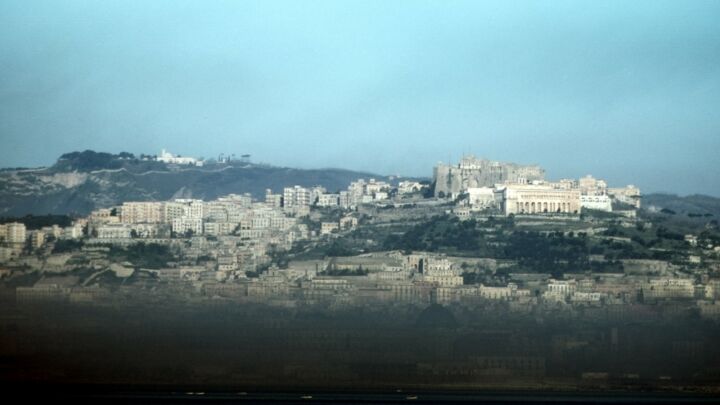
Long-read
Modern art is not rubbish
Matthew Collings on meaning, abstraction and why judgementalism can be a problem.
Want to read spiked ad-free? Become a spiked supporter.
While many are quick to dismiss modern art, arguing that it is financially driven, lazy or just shallow, Matthew Collings, a critic, writer and, alongside his artistic collaborator Emma Biggs, an artist himself, is different. He is generous with his judgement, and searching in his criticism. His numerous TV documentaries for Channel 4 and the BBC, from This is Modern Art, which won him a BAFTA in 1998, to The Rules of Abstraction in 2014, take modern art seriously. And in doing so, they take the viewer seriously, too, challenging us to shake off our preconceptions and really look at particular modern art works, and engage with what an artist is trying to do.
To find out more, the spiked review spoke with Collings about the state of modern art today, the nature of judgement and how his own art influences his approach to criticism.
spiked review: What is the meaning of abstract art? In a sense, all art abstracts from reality in some way, from Medieval religious allegories to the Republican symbolism of French Romanticism. So what, if you like, is so abstract about abstract art?
Matthew Collings: There is no single meaning. In historic modernism it’s a development in art (mostly painting) in the 1910s, considered to be something to do with spirituality – to be spiritual was a middle-class, pan-European vogue focused on charismatic figures like Blavatsky and Steiner. (The idea was that human spirit evolves over time, and that spiritualism is a concentrated effort to further that process.) With the First World War, both the vogue in society and the movement in art died away – the first quite thoroughly, the second to a great extent but not completely. In early Sovievt Russia, there was a kind of abstraction whose form came from spiritual abstract art, but whose meaning was absolutely the opposite. It was a reformed abstraction, where the concern was to come up with models or prototypes for a new, wholly socialist society. So Malevich and Kandinsky in this picture are very different to Tatlin and Rodchenko, since the first pair is spiritual and the second not.
These complicated differences within abstract art multiply right across abstraction’s timeline: the whole of the past century and more. (One of the first abstract painters was Hilma Af Klint, in Sweden in 1905, receiving instructions from spirit beings residing in Tibet.)
For the past 100 years, there has always been some kind of abstract art, always with different aims. But abstract art also has a totemic meaning. In the minds of the general public, there is a thing given the name abstract art, which is thought to be a problem with all art (like the things given the name Duchamp or the Turner Prize). The kind of abstract art I do myself is related only very distantly to the spiritual angle, and much more closely to artists and movements where there’s a priority given to visual intensity. This could really take a figurative or abstract form. If it’s the latter, it’s just to remove distractions.
review: You’ve said before that the tendency to say ‘I could do that’ or ‘I don’t get it’ in art isn’t an adequate response to abstract art; rather, you have to read it, that it’s a heightened way of seeing. Do you think that today’s critics are too harsh on contemporary attempts at abstraction? Or do you think the idea of abstraction has become too free-floating, too much of a catch-all term, making the idea that ‘anything can be art’ fair enough?
Collings: When instances of abstract art really are about heightened seeing (they aren’t all by any means) then there is a requirement to know how to see. This grates with people because it sounds anti-democratic or even illogical – we all know how to see anything, surely. But really it’s only the same as with any medium. Even with popular forms, we’re often not aware how conditioned and trained we are as receivers. So with abstract art, as with any art, you get something from it if you’ve become familiar with art generally – if you can read art. If art is always something of an alien territory for you, then you’re likely to relate more easily to an instance of it that has elements of familiarity than to another that doesn’t. That is, if there’s a descriptive element, whatever is being described can be responded to as if the response is to reality. (It’s illusory but a feeling of satisfaction from doing it compensates for it not being real.) If there’s no descriptive element and you’re being asked instead to think about the artist’s concerns beyond description, but you’ve no idea how to gauge or read those concerns, you’ll be all at sea. You’ve got to find out how abstract art might be expressive of reality, but also how any art is. When acquiring familiarity with the codes of art, you come to realise that reality in a picture of reality isn’t actually reality. And, conversely, a painting or other art object lacking a picture of reality isn’t necessarily inexpressive of anything in reality or on the run from reality.
As to whether critics might be too harsh today on abstraction, it depends which critic and which instances of abstraction. Art has in fact become a free-for-all, and anything at all can be art. This development hasn’t got any more to do with abstraction than anything else. But as far as very visually intense abstract art goes, it’s not a good development. A chaos is monotonous, not intense – the same as excessive predictability is monotonous.
review: How does being an artist affect your work as a critic? Does it make you more sympathetic, for instance? Does it give you an extra insight into the creative process of another?
Collings: I think it does give me some insight into any type of art that’s fundamentally predicated on making. Where it’s more conceptual, I’m like anyone else – I have to go by wider experience than issues of making as such.
review: The act of judgement, of ascribing value to a work and of saying whether it is good or bad, does seem to have been made difficult by a vague relativism. There is a sense that all judgements are subjective and of equal value. But are some judgements more valuable than others?
Collings: You have to judge things in art by what is relevant to the type of art it is. So you have to be aware of what you’re looking at. Martin Creed’s Work No. 227, The Lights Going On And Off in the Turner Prize in the 1990s is different to Dana Schutz’s painting Open Casket, depicting Emmet Till in his coffin, which has caused a scandal in the art world this year. Each has a great many levels of possible interpretation, societal, formal, all sorts. And, meaningfully, to judge if the work is any good or not – good and bad is after all what judgment is always about – you’ve got to explore all those levels. You’ve got to know what you’re talking about and maybe you’ve even got to make it clear that you are, in fact, judging.
It’s not always necessary for art-critical comment to include judgement. You might just be explaining or promoting or drumming-up enthusiasm. If you’re being judgmental, then for the thought to be important and relevant you’ve got to make it clear that you’re judging – you’ve got to argue the case. Expressing hostility (whether it’s with light comic wit or in a leaden, solemn and moralising voice, or anywhere along the spectrum between these poles) will never communicate anything more than that rather uninteresting level of meaning: it’s just your personal subjectivity on display, devoid of ideas. So a judgment is valuable according to the values of whoever is receiving it. If they only want either laughs or tut-tutting, then critical, pure subjectivity will be fine. If the reader values objectivity, then that other stuff might be fine as far as it goes, but it will be disappointing if it’s all there is.
review: There have been many attacks over recent decades on the idea of a Western canon of art – that it is a product of, and reinforces, social power relations (historical and contemporary), subordinating and excluding some according to gender, race and so on. Do you think an artistic canon is still worth defending?
Collings: No, the attacks are right. You have to defend things in historic art that are good. But you’ve got to argue the case of goodness or value in the first place. (Ideology-critique is right.) In my case, thinking of the art I do with Emma Biggs, and our ideas in relation to it, we’re concerned that the baby not be thrown out with the bathwater as far as ideology-critique goes. But we don’t demand that everyone go around seeing Rembrandt, or whoever, as beyond criticism. We think the exact opposite, in fact. Without a critical mind and a capacity for judgment, there’s no real point to art. Artistic judgment and criticality for us is related to all judgment and all criticality. It’s not identical, but you go from it to everything else.
review: You’ve written scathingly of certain contemporary artists, especially of those who seek commercial fame over artistic vision. Do you think that’s a problem in contemporary art? Has finance begun to play too big a role in the art world?
Collings: When I’ve been scathing about commercialism, it hasn’t been in a vacuum. What I mean is, it’s not my only or main concern. When I don’t think something is much good, it can be poorly or greatly rewarded financially, it wouldn’t make a difference. When finance is the focus, either positively or negatively, it’s equally irrelevant to artistic ideas. To a great extent, these can be considered separate from finance. A horrible fiend of finance like Damien Hirst is capable of great effective artistic ideas, and a lot of grumpy painters in cold studios complaining about Hirst frankly aren’t much good. Critics, however, who suck up to the market are of no use to anyone for whom the market isn’t the only concern. If it is, those critical voices will be the relevant ones for you. There are plenty of them, and I even get on with some of them as people, and appreciate their writing style. I even appreciate the financial information they offer in their articles. But I know, at the same time, that any comment purporting to be critical or judgmental in these articles is completely meaningless other than as a code for saying something financial. And I have the same sense of art critics that go on about poetry or the profundity of Samuel Beckett as measures for assessing the worth of a work of art. I like Beckett, and poetry, of course. But it’s a question of critics hitting the mark or not – and what you think, as a reader, the mark is.
review: There has been a significant shift away from painting, with many young artists now opting to use performance and immersive theatre as a means to explore artistic intention. Do you think that this is the natural progression of abstract art, to remove the idea further away from the canvas?
Collings: No, not at all, in the sense I think you’re saying. Historically, Abstract Expressionism, a primarily painting movement in the 1940s and 50s, was a movement from which the phenomenon you’ve mentioned originally came from. It might look back beyond it to precedents in earlier modernism, in Dada and so on in the 1910s, but it was really Abstract Expressionism’s philosophical meanings or implications that were followed up by Performance and Body Art and so on. These fall-out movements dropped the aspect of Abstract Expressionism to do with freeing up painterly meaning, and pursued its other more existential aspects, finding an appropriate form for them outside of painting.
review: You’ve written impressively of the role of intention in abstract art. Malevich’s Black Square is bursting with intention and meaning – it’s the outcome of a long thought process, experimentation, meticulous planning and consideration. Is it necessary to grasp the intention of an artist to make sense of the art?
Collings: Only if the artist’s intentions are what you’re interested in. Art has an objective meaning free of intentions. Just as it has meanings free of societal meanings – it has artistic meanings. Intention is complicated because people who are artists don’t always know what their intentions are – also, artists lie. Historically, if you’re exploring what artworks meant at the time, whether it’s late Antiquity, the Renaissance or Russia in the 1910s, you’ve got to do a lot of research into a particular society’s priorities. You’ve got to look at what the culture of the period was capable of expressing. A critical take on a historic artwork is different to a historian’s, because, as a critic, you’re part of your own time’s meaning making. Your own culture has its priorities and interests and they’ll affect your looking. You’re very much allowing that. This is the case even if you’re looking far back in time.
review: Finally, which living artist’s work would you recommend to people and why?
Collings: I saw a Chris Ofili show the other day, at the National Gallery, that was remarkably feeble, as his work has been for about 15 years. But for 10 years before that, it was funny and critical. It combined radiant beauty with a scorching commentary on contemporary life. I think this is a great combination for any artwork or body of work. So I would recommend to anyone to seek out those 1990s paintings by Chris, from The Adoration of Captain Shit to Affrodizia, and from The Holy Virgin Mary to Bitches Tossing their Pussies Before the Divine Dung. They’re models of what art is capable of in our time.
Matthew Collings is an artist, author and critic. He is currently working on a new book about contemporary painting, to be published next year by Thames & Hudson. You can find his work with Emma Biggs at Biggs & Collings.
Celebrate 25 years of spiked!
A media ecosystem dominated by a handful of billionaire owners, bad actors spreading disinformation online and the rich and powerful trying to stop us publishing stories. But we have you on our side. help to fund our journalism and those who choose All-access digital enjoy exclusive extras:
- Unlimited articles in our app and ad-free reading on all devices
- Exclusive newsletter and far fewer asks for support
- Full access to the Guardian Feast app
If you can, please support us on a monthly basis and make a big impact in support of open, independent journalism. Thank you.










Comments
Want to join the conversation?
Only spiked supporters and patrons, who donate regularly to us, can comment on our articles.